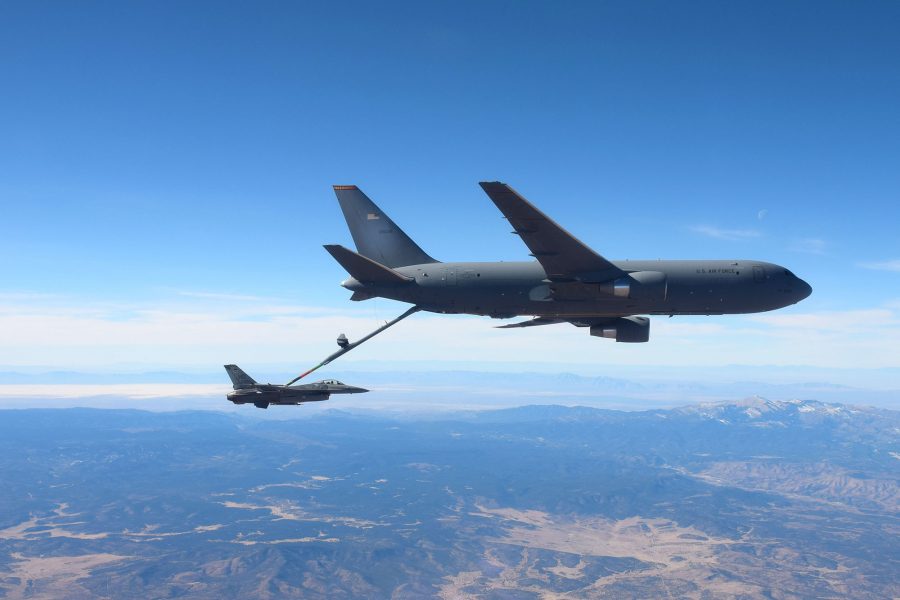The KC-46A is a heavily modified Boeing 767-200ER multirole passenger/cargo-tanker equipped with flying boom and probe/drogue refueling capability using the Wing Air Refueling Pod (WARP) system. It is also equipped for aeromedical evacuation.
KC-46 incorporates the 787’s state-of-the-art cockpit, a fly-by-wire boom, remote boom-operator’s station, advanced self-defensive suite including Large Aircraft IR Countermeasures (LAIRCM), RWR, tactical situational awareness, comms relay hosting, and nuclear/chem/bio hardening. In 2011 Boeing was awarded a contract for 179 KC-46A tankers, the first increment (KC-X), to replace about half of USAF’s KC-135R fleet.

Compared to the 50-year-old KC-135, the KC-46A has more fuel capacity, improved efficiency, and enhanced cargo and AE capability. Like the KC-10, it employs an advanced refueling boom and independently operating hose/drogue system.
The program’s provisioned 767-2C prototype (minus refueling boom) flew on Dec. 28, 2014, and received FAA type certification in December 2017. USAF accepted its first production KC-46 from Boeing on Jan. 10, 2019. The service awarded LRIP contracts for 19 aircraft in 2016, a follow-on Lot 3 contract for 15 aircraft in 2017, 18 aircraft in 2018, 15 in 2019, and 27 in 2021.
USAF awarded the most recent Lot 6 and Lot 7 contracts for a combined 30 aircraft in August 2022 and January 2023, raising the quantity on contract to 124 airframes. Full-rate production was initially planned for Lot 3 but has been pushed to Lot 10 due to program delays. FY23 funds support purchase of 15 tankers.
The KC-46 completed developmental testing and entered operational testing in 2019, though planned IOC and full-rate production has slipped to FY24 or later due to remaining deficiencies with the boom and remote vision system (RVS). USAF accepted Boeing’s revised 3-dimensional RVS design comprised of six color/IR cameras in April 2022, and aims to field the system on the KC-46 in 2025. AMC began employing KC-46 for noncombat refueling of a limited number of types starting in 2021 and cleared the type for worldwide combat support to 85 percent of receiver types in September 2022.
USAF aims to test the first element of its Advanced Battle Management System (ABMS), a C2 pod to networking fifth-generation aircraft in high-threat environments, on the KC-46 as early as 2024. KC-46 set an endurance record of 24.2 hours aloft as well as experimenting with reduced crew, flying with a single pilot and boom operator in 2022. USAF is considering an upgraded KC-46 as one option for a possible 75-aircraft “bridge” to a next-generation, possibly stealthy, tanker. March was selected as the next preferred alternative base to host KC-46s.
Contractor: Boeing.
First Flight: Sept. 25, 2015 (KC-46A).
Delivered: December 2018-present.
IOC: FY24 (planned).
Production: 179 (planned).
Inventory: 52 (KC-46A).
Operator: AFMC, AMC, ANG, Boeing.
Aircraft Location: Altus AFB, Okla.; Edwards AFB, Calif.; McConnell AFB, Kan.; Paine Field, Wash.; Pease ANGB, N.H. Planned: JB McGuire-DixLakehurst, N.J.; Seymour-Johnson AFB, N.C.; Travis AFB, Calif.; others TBD.
Active Variant: •KC-46A. Modified Boeing 767 designed as a multirole cargo tanker.
Dimensions: Span 156 ft, length 165.5 ft, height 52.8 ft.
Weight: Max T-O 415,000 lb.
Power Plant: Two Pratt & Whitney PW4062, each 62,000 lb thrust.
Performance: Speed 650 mph, range 7,350 miles (farther with air refueling).
Ceiling: 43,000 ft.
Fuel Capacity: 212,299 lb., max transfer load 207,672 lb at 1,200 gpm (boom), 400 gpm (drogue).
Accommodation: Two pilots, boom operator, and up to 12 additional crew; 15 crew seats, incl AE crew.
Passenger Load: 58 or up to 114 for contingency operations. AE load: 58 patients (24 litters and 34 ambulatory).
Cargo Load: 18 pallet positions, max 65,000 lb.
